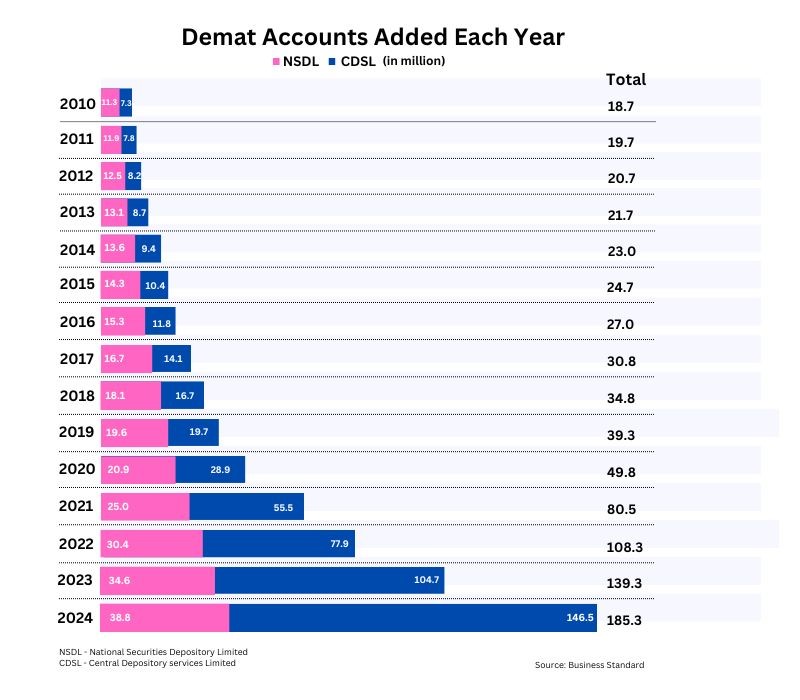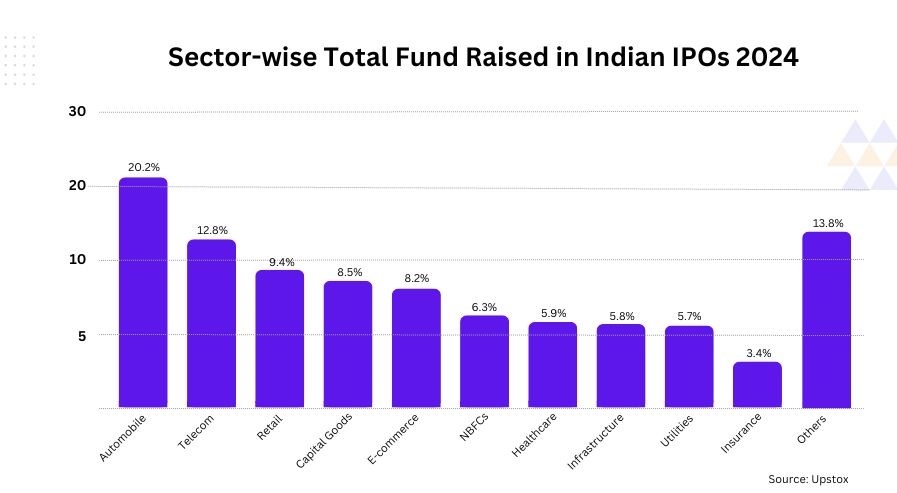Table of Contents
Introduction
1. Shift in Domestic Investment Trends
2. SEBI’s Regulatory Updates
3. Rise of Startup IPOs in India
4. Impact of Liquidity and Foreign Investments
5. Post-Pandemic Economic Recovery
2024 – A Record-Breaking Year for Indian IPOs
Top IPO Gainers and Underperformers of 2024
What’s Ahead for IPOs in 2025
India’s IPO market set a new record in 2024, becoming the world’s leader in IPO listings. With 337 IPOs across mainboard and SME segments, India outpaced the United States (183 issues) and Europe, achieving more than twice the number of listings.
India also surpassed China in both deal value and volume. Companies raised a total of ₹1.6 lakh crore ($19.9 billion), contributing 30% to global IPO activity—up from 17% in 2023.
From the post-pandemic recovery to SEBI’s new regulations, several factors have fueled India’s record-breaking IPO boom and drove strong post-listing performance. Let’s look at what boosted the market and how it made a difference.
1. Shift in Domestic Investment Trends
One of the biggest catalysts behind India’s booming IPO market is the growing shift from traditional savings to capital markets. Indian investors, who once preferred bank deposits and real estate, are now actively investing in stocks and mutual funds.
This shift has been largely influenced by regulatory changes by SEBI, making mutual funds more cost-effective. A key reform was the exclusion of fund manager fees from the expense ratio, reducing costs and increasing fund attractiveness.
Additionally, SEBI enhanced the Basic Services Demat Account (BSDA), allowing small investors with lower investment requirements to participate.
This growing preference for market-linked investments has fueled a surge in demat accounts, rising from pen their participation in stocks and mutual funds, IPOs also emerged as an attractive avenue for potentially higher returns.

2. SEBI’s Regulatory Updates

A series of regulatory reforms by SEBI has reshaped India’s IPO landscape, making the process faster, more transparent, and investor-friendly. A significant change was reducing the time from issue closure to listing from six days to just three, making the process more attractive for both companies and investors.
New Timeline:
- T+1: IPO allotments finalized by 6 PM.
- T+2: Refunds processed for unsuccessful applicants.
- T+3: IPO shares are listed and available for trading.
This change benefits both companies and investors by reducing waiting times and improving liquidity.
Other important updates include
Stricter Fund Utilization Rules: To ensure transparency, companies raising funds for acquisitions or expansion must clearly state their targets and details of fund usage in the prospectus. If a company fails to specify its target, the amount allocated for investment and acquisitions cannot exceed 25% of the total IPO capital. This prevents the misuse of funds and helps investors make informed decisions.
Extended Lock-In Period for Anchor Investors: To prevent stock price crashes, SEBI changed the lock-in rules for anchor investors (big investors who invest ₹1 crore or more in IPOs).
- Earlier: They could sell all their shares after 30 days.
- Now: They can sell only 50% after 30 days and the rest after 90 days.
This rule stops big investors from cashing out too soon, keeping stock prices stable and protecting small investors.
Restriction on Offer for Sale: Previously, IPOs allowed promoters and investors to exit by selling large portions of their holdings. SEBI introduced new restrictions to limit such sales:
- Stakeholders with more than 20% holdings can sell only 50% of their shares.
- Stakeholders with less than 20% holdings can sell up to 10%.
This change aims to maintain market stability and prevent excessive offloading during an IPO listing.
3. Rise of Startup IPOs in India

India’s expanding startup ecosystem has been a major driver of the IPO boom. Over the years, several startups have reached unicorn status—valuations of over $1 billion—and many have successfully gone public.
IPOs of companies like Zomato, Paytm, Nykaa, and Policybazaar have highlighted the maturity of India’s startup sector, making the country a key player in the global tech space.
For startups, listing on the stock exchange offers an opportunity to raise capital, reward early investors, and gain market visibility. It also allows retail and institutional investors to participate in the growth of well-established startups that have already proven their business models in private markets.
4. Impact of Liquidity and Foreign Investments
The availability of liquidity has also contributed to the IPO boom. The Reserve Bank of India (RBI), like many central banks worldwide, maintained a supportive monetary policy during and after the pandemic.
Low interest rates and ample liquidity encouraged investors to turn to equities, including IPOs, in search of better returns.
Additionally, foreign portfolio investors (FPIs) have shown strong interest in Indian equities, further boosting IPO activity. India’s stable macroeconomic outlook and long-term growth potential have made it an attractive destination for global investors looking for emerging market opportunities.
5. Post-Pandemic Economic Recovery
India’s post-pandemic recovery has reignited business confidence, prompting a surge in IPO activity. The pandemic-induced slowdown had put many listing plans on hold, but as business confidence recovered, companies rushed to capitalize on improved market sentiment.
Government stimulus measures and supportive monetary policies created a favorable fundraising environment. Additionally, high-growth sectors like technology, healthcare, and e-commerce, which thrived during the pandemic, saw increased investor interest, further accelerating IPO activity.
These factors collectively fueled India’s record-breaking IPO boom in 2024. With strong investor participation, regulatory support, and a thriving startup ecosystem, the IPO market continues to be a key driver of capital growth.
2024 – A Record-Breaking Year for Indian IPOs
These above-mentioned factors not only helped Indian IPOs raise $19.9 billion (₹1.6 lakh crore) in 2024—more than double the previous year’s total—but also drove strong post-listing performance.
Of the 93 Mainboard IPOs, 74 closed higher on the listing day, and 65 remained above their issue prices (as of January 22, 2025).
Here are the top 10 IPOs that contributed the mos t, based on issue size.
| IPO | Issue Size |
| Hyundai Motor India (NSE: HYUNDAI) | 27,870.16 crore |
| Vodaphone-Idea | 18,000.00 crore |
| Swiggy. Limited | 11,327.43 crore |
| NTPC Green Energy (NSE: NTPCGREEN) | 10,000.00 crore |
| Vishal Megamart Limited | 8,000.00 crore |
| Bajaj Housing Finance Limited | 6,560.00 crore |
| Ola Electric Mobility Limited | 6145.56 crore |
| Afcons Infrastructure Limited | 5430.00 crore |
| Waree Energies Limited | 4321.44 crore |
| Bharati Hexacom Limited | 4275.00 crore |
India witnessed its largest IPO ever in 2024, with Hyundai Motor raising ₹27,870 crore ($3.3 billion)—surpassing LIC’s ₹20,557 crore issue from May 2022. Hyundai also ranked as the world’s second-largest IPO of the year.
Unlike previous years, 2024 saw IPOs across 23 different industries, with Automobiles, Telecom, Retail, Capital Goods, and E-Commerce accounting for 59% of the total issue size—a significant shift from 2021, when BFSI, Healthcare, and Real Estate dominated 90% of IPO proceeds.

India’s IPO Market Outshines Global Peers
Globally, IPO activity declined in 2024, with the total number of IPOs dropping by 10% to 1,215. While regions like the Americas and EMEIA (Europe, Middle East, India, and Africa) contributed to the recovery, the Asia-Pacific region experienced a slowdown in early 2024, with signs of revival in the latter half.
Despite the global slowdown, India’s IPO market emerged as a standout performer, delivering record-breaking numbers and surpassing many emerging markets. With an impressive average return of 37.1%, Indian IPOs outshined Europe’s 20.6% and significantly outpaced the BSE Sensex’s 7.3% gain in 2024.
Top IPO Gainers and Underperformers of 2024
Beyond record-breaking fundraising, several IPOs delivered exceptional listing gains, rewarding early investors with substantial first-day returns. Companies from renewable energy, finance, and technology sectors led the pack, outperforming expectations and reinforcing investor confidence in the primary market.
The table below highlights some of the top-performing IPOs of 2024, showcasing their issue prices, listing prices, and the impressive gains they delivered on debut.
| Company Name | Issue Price (₹) | Listing Price (₹) | Listing Gain (%) |
| Waree Energies | 1,503 | 3,293 | 119% |
| Vibhor Steel Tubes | 151 | 425 | 181% |
| BLS E-Services | 135 | 305 | 126% |
| Bajaj Housing Finance | 70 | 150 | 114% |
| Premier Energies | 450 | 990 | 120% |
However, not all IPOs lived up to investor expectations. While 2024 saw significant success stories, a few public offerings struggled on debut, with some listing below their issue prices. Market sentiment, overvaluation concerns, and sector-specific headwinds played a role in dampening their initial performance.
| Company Name | Issue Price (₹) | Listing Price (₹) | Listing Gain (%) |
| Deepak Builders $ Engineers | 203 | 200 | -1% |
| Western Carriers | 172 | 171 | -1% |
| Suraksha Diagnostic | 441 | 438 | -1% |
| Kross | 240 | 240 | 0% |
| Bazaar Style Retail | 389 | 389 | 0% |
Despite these mixed results, the broader IPO market in 2024 demonstrated strong investor appetite, diverse sector participation, and heightened institutional interest, setting the stage for a dynamic primary market in the years ahead.
While technology and renewable energy IPOs delivered strong listing gains, some public offerings struggled, underscoring the need for careful investment decisions.
These mixed results emphasize the importance of thorough research, market awareness, and a solid understanding of company fundamentals before investing in newly listed stocks. As the market continues to evolve, staying informed and adopting a strategic approach can help investors capitalize on IPO opportunities while mitigating potential risks.
What’s Ahead for IPOs in 2025?

Indian IPOs have had a weak start in 2025, with 4 out of 9 Mainboard offerings trading below their issue price (as of February 25, 2025).
The broader stock market is also under pressure, with the BSE Sensex down 11.64% and the Nifty50 dropping 12.68% from their all-time highs.
Adding to the concerns, foreign institutional investors (FIIs) have pulled out over ₹1.12 lakh crore from equities so far in 2025 (till February 21). In January alone, FIIs withdrew ₹81,903 crore, driven by global tensions after the U.S. imposed new import tariffs.
Meanwhile, China’s stock market has staged a strong recovery, making Indian equities less attractive. As a result, global investors are shifting towards a ‘Sell India, Buy China’ strategy.
On the other hand, domestic institutional and retail investors are expected to play a larger role in India’s IPO market.
With rising incomes, increasing financial awareness, and better access to digital investment platforms, their participation could grow further. This shift may help offset foreign outflows and bring more stability to the Indian market.
In IPO – So far, nine Mainboard IPOs, including Hexaware Technologies, have raised approximately ₹15,108 crore. However, weak market sentiment has led to lower-than-expected subscription levels.
Despite this negative market performance, the IPO pipeline remains strong. According to PrimeDatabase, 44 companies have already secured SEBI approval, aiming to raise ₹66,095 crore. Additionally, 67 more companies have filed draft papers, collectively targeting ₹1.17 trillion.
While short-term challenges persist, India’s IPO market still holds significant fundraising potential in 2025.
Market experts remain divided on how the primary market will perform in the coming months, as uncertainty continues to shape investor sentiment.
Some experts believe that once the volatility subsides and market stability returns, Indian IPOs could see a strong rebound. A revival in investor confidence, coupled with a robust pipeline of upcoming listings, could drive renewed interest and healthier subscription levels in the latter half of 2025.
Big names expected to hit the IPO market in 2025 include Reliance Jio, PharmEasy, JSW Cements, Go Airlines, and more.
While the current market faces headwinds, the strong pipeline of upcoming IPOs signals that companies remain optimistic about raising capital.
If market conditions improve and investor sentiment recovers, India’s IPO market could regain momentum, making 2025 another significant year for public listings




